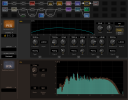That’s fine for low volume, bedroom jamming. I’m betting if you crank that up in a loud band type environment it’s gonna sound harsh. Remember a real guitar speaker doesn’t typically produce much, if anything above 6k anyway. Everyone’s tastes are different.

This is what I've been saying and trying to understand for a long time.Guitar cab IRs mimic the limited frequency response of a guitar cab though.
Why should we need to limit it further?
Well, to maybe partly answer my own question, it could be because that kind of tonal processing is commonly done in the studio to make the parts fit well with each other, and those are the tones we've gotten used to.Guitar cab IRs mimic the limited frequency response of a guitar cab though.
Why should we need to limit it further?
Ok, asked and answered, thank you.

One's not better than the other, they're at different points in the chain, so they behave differently.Guys - this has been super interesting and helpful. I've been doing my low and high cuts in the amp block (in the Input EQ section). But it looks like many of you are doing it in the cab block. Is there any reason why cab block is better than amp block? Thank you.
Interesting points ….So, I understand the reason for the low and high cuts (to create a more amplike frequency envelope) and do employ these in most circumstances, but I wonder...since our Fractal units are not merely amp simulators, but rather amp + efx simulators, does the 80-6000 hz (or whatever) envelope still provide all the audible information that is produced by the whole amp + effects chain when you attenuate those lows and highs?
Put another way, do the reverbs, filters, delays, etc. sound the same with a lowpass @ 6000hz, or is there an attenuation of important auditory cues as a result? The amp sim might be fine, but what about things like early reflections in a tiled room, etc.? It seems to me that a lowpass, and possibly even a highpass, filter would severely degrade a number of effects, if not the actual amp sim, in a given patch.
 I’m a have to think about this some more…
I’m a have to think about this some more…Yeah, no one else has responded, but I suspect it's because it's a complex "system" issue.Interesting points ….I’m a have to think about this some more…
Yeah, no one else has responded, but I suspect it's because it's a complex "system" issue.
After all, even if you're onstage playing thru a 120-6k hz amp, your ears hear higher and lower than that, glasses clinking, etc., AND high-fidelity sound processing (such as delays, reverbs) added AFTER the amp block are not being cut, so what is the resultant "best practice"? Is it low and high cuts to mimic the amp in isolation, or 20-20k to capture the full frequency information that your (theoretically perfect) hearing picks up--or some compromise?
For what its worth, I run single 57 IR's. Typically my cab preamp cut is 120 @ 12dB, 8k @ 6dB.I've been experimenting at band practice stage volume with this. I leave my live preset alone and all i adjust is cab block high cut. Last week i tried 8000k 12db slope and i got buried in the mix. Thats with me on the mixer knowing where everyone is each week when we practice also. The week before i did wide open at 20k and it cut way more but was a pinch harsh. I dialed this week at home and it seems around 14k is a sweet spot to my ears. Cuts off some super highs but lets the ir breathe if that makes sense. I went to a local metal show last week and the two bands using axefx3's had the worse tone that the bands using real amps. In both cases the direct bands were using ir's that in my opinion were way to dark or had to much highcut. The real amps mic'ed with a 57 were borderline harsh during soundcheck. When the whole band played it sounded fine though. Just my 2cents.
For what its worth, I run single 57 IR's. Typically my cab preamp cut is 120 @ 12dB, 8k @ 6dB.
Cool. I feel like not enough users try replicating what would actually happen in a live environment before making all the tweaks, cuts, multiple mics, etc. I also have a feeling that some users think they need add a ribbon mic to get low end. Personally, I've never had an issue with low end from a live stage standpoint... I actually have to take more out sometimes. The 57+121 mixes always seem hollow sounding to me and I most of the time hear myself get lost in the mix. I do like a 57+421 sometimes too.I also am running single 57 IR's for live. I like the mixes and blends at home but its hard to beat the cut of a 57 live. I should've clarified that. Everything in my prior post is using single shot 57 IR's.
Cool. I feel like not enough users try replicating what would actually happen in a live environment before making all the tweaks, cuts, multiple mics, etc. I also have a feeling that some users think they need add a ribbon mic to get low end. Personally, I've never had an issue with low end from a live stage standpoint... I actually have to take more out sometimes. The 57+121 mixes always seem hollow sounding to me and I most of the time hear myself get lost in the mix. I do like a 57+421 sometimes too.
I don't record though, mostly live gigs.
YMMV.

